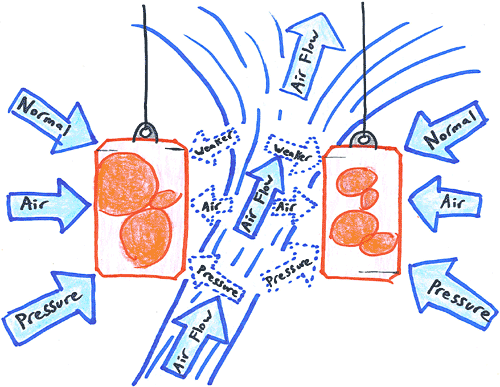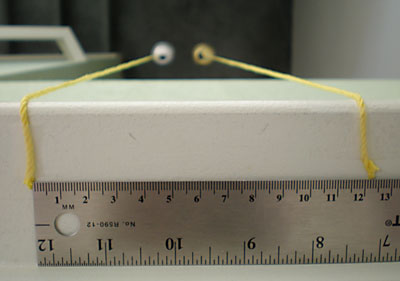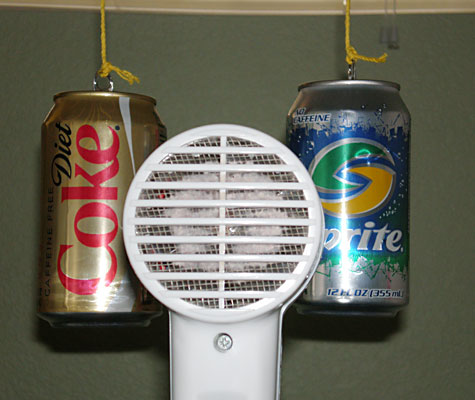Introduction
Have you ever wondered how airplanes are able to take off into the air and fly? Or why race cars have airfoils on their back sections? Both airplanes and race cars take advantage of Bernoulli's principle, also called the Bernoulli effect, to help control their movements. In the case of the airplane, it gets part of its lift from the Bernoulli effect. In the case of the race car, the Bernoulli effect helps to keep its wheels in contact with the racetrack at high speeds.
The Bernoulli principle describes the relationship between velocity and the pressure exerted by a moving fluid (liquid or air). It states that as the velocity of a fluid increases, the pressure exerted by that fluid decreases. One real-world example of this principle is when air is forced to move at a high speed from a tube, such as a hair dryer or leaf blower. In the region where the air is moving, the Bernoulli principle indicates that the pressure is lower than in the surrounding stationary air. If you have a region of low pressure near a region of high pressure, air will move into the region of low pressure. The air moves because the force of the low-pressure region is less than that of all other forces acting on the air. See Figure 1, below.
In this science fair project, you will observe the forces acting on the air by watching two light objects (soda cans) move toward the air flow. You will change the speed of the airflow and the distance between the two cans to see what happens to the objects. How do both speed and distance work with the Bernoulli effect? Does a higher speed make them fly together sooner? Does a greater distance make them come together more slowly?

Figure 1. An increase in air velocity between the cans weakens the air pressure between them, causing them to be pushed together.
Terms and Concepts
- Bernoulli's principle, or the Bernoulli effect
- Velocity
- Pressure, specifically air pressure
- Fluid
- Force
Questions
- What is Bernoulli's principle?
- What are some real-world applications of Bernoulli's principle?
- Why would an object move when the pressure on one side is lowered?
Bibliography
This website offers a good explanation of air pressure, also known as atmospheric pressure:
- SAIC Information Services and Sample, S. (2003, January 22). Atmospheric Pressure: The Force Exerted by the Weight of the Air. Retrieved July 22, 2008, from http://kids.earth.nasa.gov/archive/air_pressure/
Materials and Equipment
- Soda cans, emptied and rinsed out (2)
- String, several feet
- Scissors
- Clear tape, or masking tape
- Ruler, preferably metric
- A helper (optional)
- Hair dryer or small, strong fan with more than one speed setting
- Ruler
- Stopwatch
- Lab notebook
- Graph paper
Experimental Procedure
In this experiment, you will be hanging two empty soda cans in midair and blowing air between them to see what happens when air pressure changes. Why do you think that the cans are hung instead of set on a table?
- Find a place to hang the cans in your house, such as from a loft or from a non-sloping ceiling. It should also be near an electrical socket. Cut several feet of string for each can, so when they are hung, they are at about chest level for you.
- Bend each can's tab so that it is vertical (see Figure 2), and then tie a piece of string to each one.

Figure 2. The tabs of these cans have been bent vertically so that they will hang properly. - You might want a helper to assist you with this step. Hang the two cans with tape so that they are level with each other. There should be 12 cm between the taped ends of the string (see Figure 3, below) and they should be at your chest level as they hang. Make sure that you can easily access the taped parts of the strings because you will be moving them farther apart as you test Bernoulli's principle, so will need to measure and record the changing distances. Note: You might need a helper who can stand on a chair to tape the string to the ceiling or high location and continue to do so throughout the experiment. Use caution if you are using a ladder or chair to stand on.In the following steps, you will be using air pressure to move the objects. The region between the two cans will be the low-pressure region, and everywhere else around each can will be a high-pressure region. The difference in pressure between the cans will cause the cans to move because the higher pressure outside the cans is a stronger force than the low pressure between the cans. Ultimately, this pushes them together. By blowing the air, you're not pulling the objects closer, you're weakening the air pressure that keeps them separated.

Figure 3. These cans were hung from a loft by a staircase. From this view, you can see the distance between the strings, and the cans hanging on the first floor. - Have your stopwatch ready and your hair dryer plugged in. You will start the stopwatch when you turn on the hair dryer and stop it when the cans collide. You might want to have someone help you—have the helper use the stopwatch while you use the hair dryer. Make sure the hair dryer is set to its lowest speed setting.
- Aim the hair dryer directly between the two cans and turn it on (see Figure 4, below). You might need to practice positioning the hair dryer to get the cans to collide a few times before you have your partner use the stopwatch. You'll probably find that it's easy to blow one can around, but you need to focus on blowing air between them. This can be tricky, especially at the lowest hair dryer speed. If the speed doesn't seem to work no matter how many times you practice, just use the next highest speed setting. Once you find the right position, measure and record the distance from the tip of the hair dryer to the cans in your lab notebook.

Figure 4. This is the proper way to aim the hair dryer—exactly between the two cans. - After you finish practicing, it's time to begin collecting data. Make a data table in your lab notebook, with a column labeled Separation Distance (beginning with 12 cm) and a corresponding column labeled Time. Get the hair dryer in the position you practiced with, aim the hair dryer properly, and turn it on at the same time the stopwatch is started. Stop the hair dryer when the cans first hit each other. Record the time in your data table.
- Repeat step 6 two more times, using the same distance between the objects and the hair dryer each time. Later, you'll find an average of the data to put in a graph. Finding averages of multiple trials is more accurate than using only one trial—what if you only did it once and made a mistake?
- Now change the distance between the two soda cans and record the distance in your lab notebook. This is done by taking one string off of wherever it is hung and increasing the distance by 1 cm, and reattaching it with the same piece or a new piece of tape. There should now be 13 cm between the strings.
- Keep the hair dryer on the same speed and repeat step 6 two more times, recording the information in your data table.
- Continue increasing the distance by 1 cm and test each new distance three times. Do this until the distance is so great that the cans no longer collide when air is blown between them.
- Calculate an average time value for each distance. Then make a graph with all of the averages, where the x-axis is Separation Distance (in cm), and the y-axis is Time (in sec). This graph represents data for the hair dryer speed setting you used.
- Now it's time to change the speed. Make a new data table in your lab notebook to record the information for this new speed setting.
- Your hair dryer should have more than one speed setting, such as low and high. Change the speed to the next highest one (if there is a next highest setting) and perform steps 3-11. Make sure you use all the same distances that you used in the previous experiment. Start with a soda can separation distance of 12 cm and increase by 1 cm until the cans no longer collide. Perform three trials for each distance. If there are more than two settings on your dryer (like low, medium, and high), then make sure to test all of them and make a graph for each one. What do the differences in the graphs mean? What do they tell you about air pressure and Bernoulli's principle?



 Figure 1. Air resistance is always in the opposite direction a vehicle is moving. As a car's speed increases, so does the air resistance (image adapted from Ebaychatter0, Wikimedia Commons, 2012).
Figure 1. Air resistance is always in the opposite direction a vehicle is moving. As a car's speed increases, so does the air resistance (image adapted from Ebaychatter0, Wikimedia Commons, 2012). ,
,